CHEMICAL COORDINATION AND INTEGRATION
INTRODUCTION
- Significance :- As the nerve fibres do not innervate all cells of the body and the cellular functions require continuous regulation, hence the role of endocrine system is integrated with neural system.
ENDOCRINE GLANDS AND HORMONES
secrete
Endocrine glands→→→→→ Hormones
(Ductless) |_______________________|
glands ↓ From |→ Invertebrates
Together regulate ← ← ←Endocrine system→→→|→ (few hormones)
physiological functions & |→ Vertebrates
in the body Neural system (manly hormones)
HORMONES
– Released into blood and transported to target organ.
– Non-nutrient chemicals.
-Act as intercellular messengers.
– Produced in trace amounts.
HUMAN ENDOCRINE SYSTEM
- Other organs with diffused tissues and cells :- gastrointestinal tract, heart, liver and kidneys.
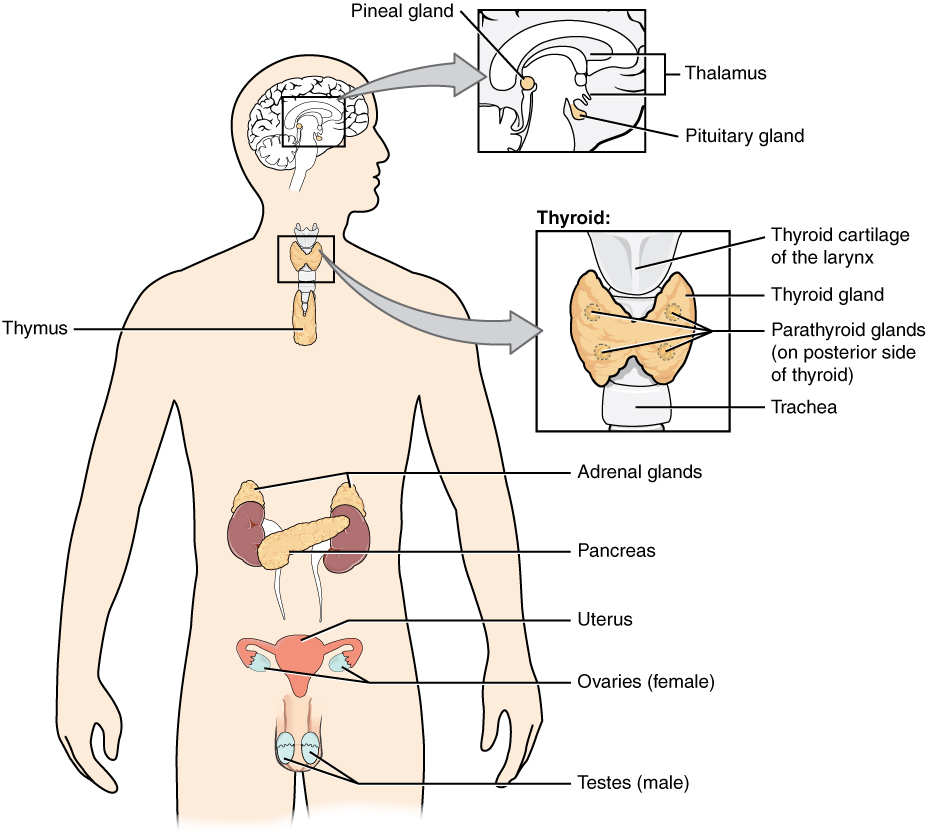
HYPOTHALAMUS AND PITUITARY GLAND
- Hypothalamus contains several groups of neurosecretory cells called nuclei which produce hormones that regulate synthesis and secretions frm pituitary gland -enclosed in bony cavity, sella turcica.
TYPES OF HYPOTHALAMIC HORMONES:-
Example Target Released hormone
Releasing GnRH Pituitary Gonadotrophins
hormone
Inhibiting Somatostatin Pituitary X
hormone
Hypothalamus
↓Connected through
Portal circulation
↓
Anterior pituitary
↓
Pars distalis Pars Intermedia
(Merged in humans)
|_______________________________|
↓
Hormones of pituitary Basic functions
Growth hormones(GH) Growth of body
Thyroid stimulating hormones(TSH) Synthesis and secretion of thyroid hormones from thyroid gland
Adrenocorticotropic Synthesis and secretion of steroid hormones(ACTH) hormones from adrenal cortex
Foloicle stimulating hormones(FSH) Male- Regulates spermatogenesis
↓ along with androgens.
↓ Female- Stimulates growth and ↓ development of ovarian follicles.
Gonadotrophins (stimulate Male- Stimulates the synthesis and gonadal activity) secretion of androgens
↑ Female- Induces ovulation of fully
Luteinising hormones (LH) mature Graafian follicle, maintains
corpus luteum.
Prolactin Regulates the growth of the mammary glands and formation of milk
in them
Melanocyte stimulating hormones Act on the melanocytes of skin and
(MSH) by pars intermedia. regulates pigmentationof skin.
Hypothalamic Neurons
↓Connected through stalk but not via portal
↓circulation
posterior pituitary
↓
Stores and release hypothalamic hormones
↓
Pars nervosa
↓
Neurohypophysis
↓
Hormones released Basic functions
Oxytocin -Acts on smooth muscles and stimulates their contraction
– Stimulates vigorous contractions of uterus at the time of child birth
– Milk ejection from mammary glands
Vasopressin/ADH/Anti- – Acts at kidney and stimulates resorption of water
diuretic hormone and electrolytes by the distal tubules.
– Reduces loss of water through urine (Diuresis).
DISORDERS
Disease Age Cause Symptoms
Pituitary dwarfish Hyposecretion of GH Stunted growth
Gigantism Hypersecretion of GH Abnormal growth
of the body
Acromegaly Middle age Hypersecretion of GH Severe disfigurement
especially of face
Diabetes insipidus Hyposecretion of ADH Diminished ability of
the kidney to conserve
water leading to water
loss and dehydration.
Note:-
ACROMEGALY:– Serious complications of hypersecretion of GH in middle age can leads to premature death if unchecked. The disease is hard to diagnosisin early stages and often goes undetected for many years, until changes in the external features become noticeable.
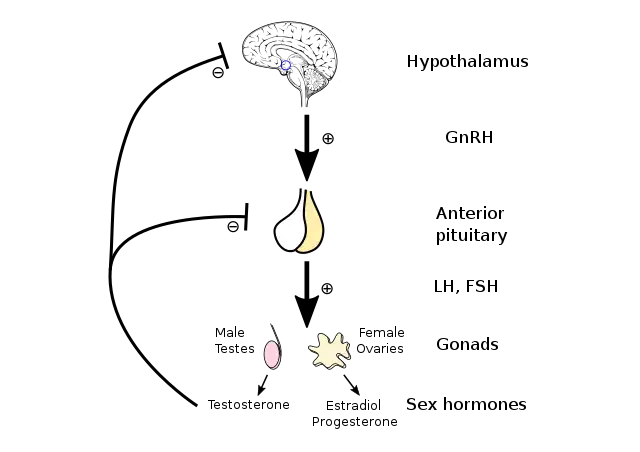
PINEAL GLAND
- Location:- Dorsal side of forebrain.
- Hormones released:- Melatonin
- Basic functions:-
– Regulate 24 hours diurmal rhythm of our body (sleep wake cycle).
– Influence body metabolism, temperature, pigmentation, menstrual and defense capabilities.
GLAND OF THORACIC REGION
Thyroid Location/ Number Hormones Basic functions
Features -Regulate basal
– Either side of 1 T4 (thyroxine) or metabolic rate
trachea tetralodothyronine (BMR)
– Bilobed structure T3 (trilodothyronine) – Control metabolism
connected through of carbohydrates
a thin flap of proteins and fats
connective tissue – Maintain water and
called isthmus electrolyte balance
-Consists of follicles -Regulate development
made up of follcular and maturation of CNS cells enclosing a -Support process of
cavity, in stromal tissue RBC formation
-Iodine is essential (Erythropolesis) and
for the normal regulates menstrual
rate of hormone cycle
synthesis in the
thyroid gland
Parathyroid – Back side of the 4 Parathyroid -Increase level of Ca+2
thyroid gland hormone/PTH (hypercalcemic)
– Thyrocalcitonin and (Peptide – Acts on bones and
parathormone play hormone) stimulates the
a significant process of bone
role in calcium resorption(dissolution)
homeostasis – Stimulates the reabsorption of Ca+2
by the renal tubules
– Increases Ca+2
absorption from
digested food
Thymus – Lebular structure 1 Thymosins – Play a role in
located between (peptide differentiation of
lungs behind hormones) T-lymphocytes, thus
stermum on ventral provide cell mediated
side of aorfa immunity
– degeneration in old – Promote production
age so immune of antibodies thereby
responses become weak providing humoral
immunity
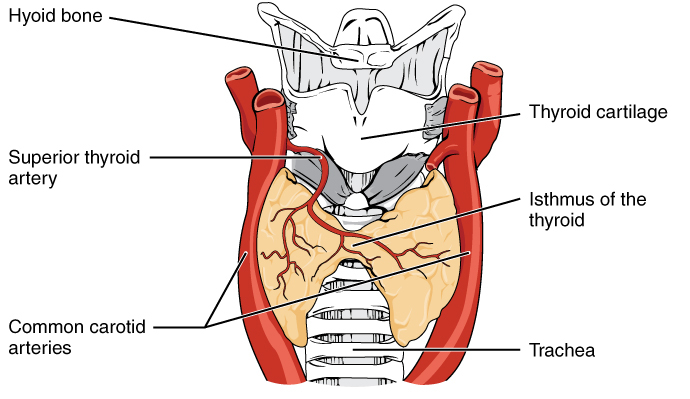
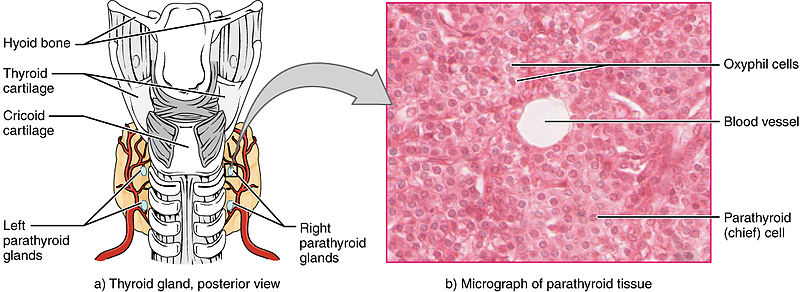
DISORDERS OF THYROID GLAND
Hypothyroidism Hyperthyroidism
cause Cause
-Iodine deficiency in diet during -Cancer of the thyroid gland
pregnancy and after birth – Development of nodules of the thyroid
gland
1. Goitre:- Enlargement of thyroid 1. Exopthalmic-goitre or
gland Graves’disease:-
2. Cretinism:- Stunted growth, mental – Enlargement of thyroid gland
retardation, low intelligence quotient, – Protrusion of eyeballs
abnormal skin and deaf-mutism. – Increase in BMR and weight loss
3. In adult women, menstrual cycle
can become irregular.
ADRENAL GLAND
- One pair located on anterior part of kidneys.
Hormone Functions
Adrenal cortex
– Zonal glomerulosa – Major -Stimulates reabsorption
(outermost layer) mineralocorticoid of Na+ and H2O and
is aldosterone excretion of K+ and PO4
ions, thus helps in
maintenance of
electrolytes, body fluid
volume osmotic pressure
and blood pressure
– Zona fasciculata – Main glucocorticoid – Stimulates
(middle layer) is cortisol gluconeogenesis,
lipolysis and
proteolysis
-Inhibit cellular uptake
and utilization of amino
acid, maintains the
cardiovascular system
and the kidney functions
– Produces anti-inflammatory
reactions and suppresses
immune response
– Stimulate glomerular
filtration rate
– Stimulate RBC production
– Zona reticularis – Andrgenic steroid – Play a role in growth of (Inner layer) axial hair, pubic hair and
facial hair during puberty
Adrenal gland
↓
Adrenal medulla – 1. Adrenalins/epinephrins – Increase alertness, pupilary dilation,
piloerection, sweating
(Centrally located) 2. Nor-adrenaline/ – Increase heart beat
nor-epinephrine or the strength of heart
Catecholamines or contraction and the rate
Emergency/ of respiration.
flight hormones -Stimulate breakdown of glycogen resulting in an
increased concentration
of glucose in blood
– Increase breakdown of
lipids and proteins
Disorder Cause Characteristic
Addleson’s – Underproduction of Alters carbohydrate metabolism
disease hormones of causing acute weakness and
adrenal cortex fatigue.
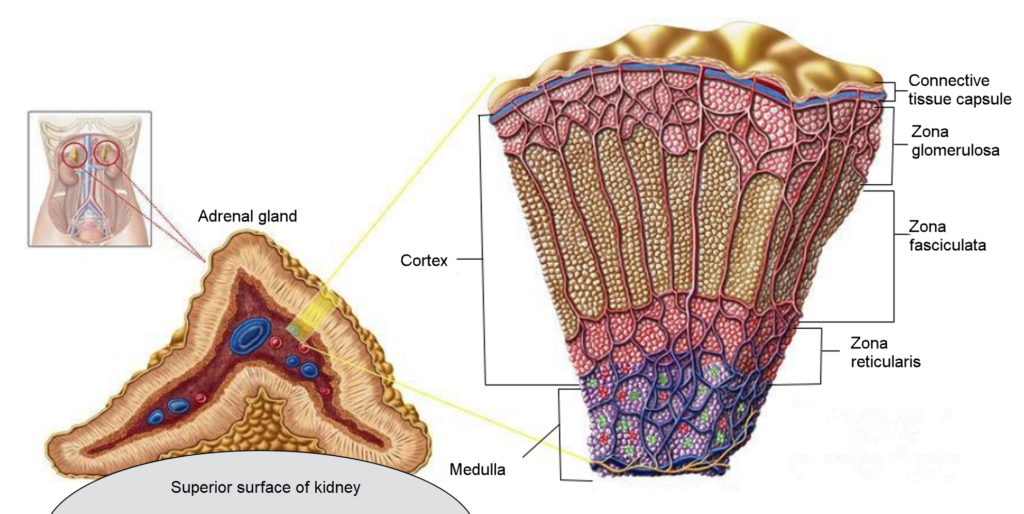
PANCREAS
- Pancreas:- A composite gland whose main hormones maintain glucose homeostasis. |_________________|
Endocrine part Exocrine part
↓
1 to 2 million lslets of Langerhans
1-2% of pancreatic tissue ↓ Major cells
|_______________|
∝-cells ß-cells
↓ peptide ↓
↓ hormones ↓
Glucagon ↔ Insulin
-Traget:- Hepatocytes Hepatocytes, Adipocytes
-Stimulates –Glycogenolysis, Glycogensis
gluconeogensis
↑ ↓
-Blood
glucose level (Hyperglycemic) (Hypoglycemic)
– Glucose
uptake and ↓ ↑
utilisation by cells
DISORDERS
Diabetes mellitus- Caused by prolonged hyperglycemia
Characteristics – Loss of glucose in urine, ketone bodies formation.
Treatment – Insulin therapy
GONADS
- Primary sex organs:- Form gametes and secrete hormones
Parameter Male(Testis) Female (ovary)
– Location Scrotal sac (outside abdomen) Ovarian follicles and
↓ corpus luteum
-Structure leydig cells/interstitial cells ↓
responsible ↓ ↓ ↓
-Steroid hormone Androgens
mainly testosterone Estrogen Progesterone
Function
– Development and maturation of- Growth and – Support pregnancy
male accessory sex organs activities of female – Stimulates
secondary sex formation of
organs alveoli (store milk)
-Stimulate spermatogenesis -Stimulate and milk secretion)
development of
growing follicles
-Acts on CNS and influence -Regulate sexual
male sexual behaviour (libido) behaviour.
– Stimulate muscular growth – Appearance of
of facial and axillary hair secondary sex
aggressiveness and low pitch characters like
of voice mammary gland
development, high
pitch etc
HORMONES OF HEART, KIDNEY AND GASTROINTESTINAL TRACT
Tissue Organ Hormone Basic function
Atrial wall Heart -ANF – When blood pressure increase, its
dilates blood vessels to
reduce blood pressure
-Juxtaglomerular Kidney -Erythropoietin -Stimulates erythropoiesis
cells (JG cells)
– Endocrine cells GIT -Gastrin -Acts on gastric glands and
in different parts stimulates secretion of HCL
of gastro-intestinal and pepsinogen
tract
-GIP/gastric – inhibits gastric secretions and
inhibitory motility.
peptide
-Cholecystokinin -Acts on exocrine part of pancreas and gall bladder
to stimulate secretion
of pancreatic enzymes
and bile juice
-Secretin – Acts on exocrine part of pancreas and stimulates
secretion of water
and bicarbonates.
– Non-endocrine – Growth factors -Essential for normal growth,
repair and regeneration
of tissues.
Note:- All these given hormones are peptide hormones.
MECHANISM OF HORMONE ACTION
- Hormone receptors are located in the target tissue only.
- Each receptor is specific to one hormone only
- Most intracellular receptors are present in the nucleus
- Steroid hormones and iodothyronines enter the target cell
- Hormones acting through extracellular receptors do not enter the target cell.
Classification of Hormones
↓ Based on chemical nature
|______________________________________________________|
– Steroids:- cortisol, testosterone, -Amino acid derivatives-
estradiol progesterone Epinephrine
Lodothyronies-Thyroid hormones Peptide, Polypeptide,protein- Insulin, glucagon, pituitary
and hypothalamic
hormones etc. Bind to |________________________________________________|Bind to
Intracellular/Nuclear receptors ↓ Extracellular/Membrane bound ↓ receptors ↓
Genome and regulate Interact Hormone Generate Second
gene expression or with receptor messengers
chromosome functions complex cAMP, IP3, Ca+3etc.
|______Brings biochemical changes in target tissue ______| ↓ Cumulative effect
Results in
Physiological and developmental effects
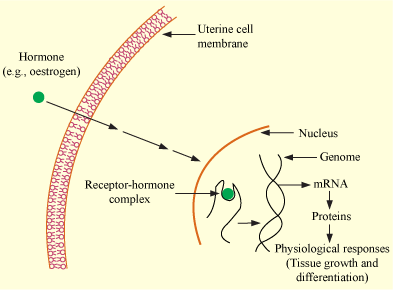
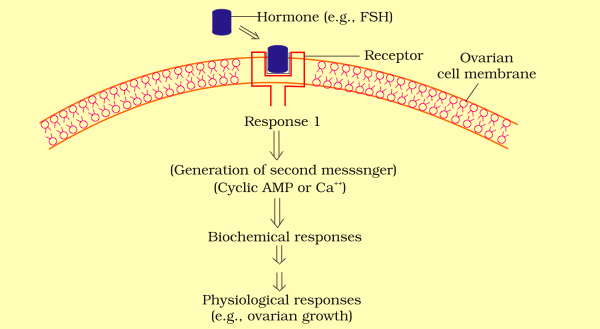
- Chemical coordination and integration refer to the regulation of bodily functions and processes through the release and action of chemical messengers called hormones. These hormones are produced by specialized glands and organs and help maintain homeostasis and coordinate responses to internal and external stimuli.
- Hormones are chemical messengers secreted by endocrine glands or specialized cells in response to specific signals. They travel through the bloodstream to target cells or organs, where they exert regulatory effects on various physiological processes, including metabolism, growth, reproduction, and stress responses.
- The main endocrine glands in the human body include the pituitary gland, thyroid gland, adrenal glands, pancreas, gonads (testes in males, ovaries in females), and the pineal gland. These glands secrete hormones that regulate a wide range of bodily functions.
- The hypothalamus and pituitary gland form a complex regulatory system known as the hypothalamus-pituitary axis (or HPA axis). The hypothalamus produces releasing and inhibiting hormones that control the secretion of hormones from the pituitary gland, which in turn regulates the activity of other endocrine glands throughout the body.
- The adrenal glands, located on top of the kidneys, secrete hormones such as cortisol, adrenaline (epinephrine), and aldosterone, which regulate stress responses, metabolism, blood pressure, electrolyte balance, and other physiological functions.